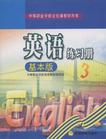英语练习册
2001-7
高等教育出版社
改编组 编
138
《英语(基本版)》是根据2000年8月颁布的《中等职业学校英语教学大纲(试行)》(以下简称“大纲”)组织编写的系列教材。本系列教材包括预备级、第l~3册、第4册(提高本),预备级配有教师手册、录音带和电子教案,其他各册均配有练习册、教师手册、录音带、多媒体学习课件和电子教案。 本教材着力体现素质教育和能力本位的精神,注重交际应用,突出职教特色,其主要特点如下。 1.与初中英语教学相衔接、紧扣大纲 本系列教材的普通起点为初中英语教学大纲要求学生掌握的600英语词,预备级起点为300词,更加贴近目前中职英语教学的实际情况。本系列教材覆盖了“大纲”的全部语法项目、所有的交际功能项目和约90%的词汇项目。学完本系列教材第1~3册将能达到“大纲”规定的基本要求,学完第1~4册将达到较高要求。 2.以话题为纲和以综合英语为基础 本系列教材每个教学单元的各种教学活动都围绕一个与学生日常生活密切相关的话题进行,由“综合英语”向“听”、“说”、“读”、“写”等交际技能和词汇、语法等语言项目辐射。同时还体现了语言项目是交际的手段、交际技能是教学目的的教学思想,把语言知识作为交际的手段来教,把交际技能作为教学的目标来培养,既重视语言知识的传授,更重视交际技能的培养。 “听”、“说”模块结合交际功能并围绕单元话题展开,充分体现了“大纲”突出实用性的要求。“综合英语”模块以相关话题为纲编写,词汇、语法的教学均围绕相关话题进行。“兴趣阅读”除进一步培养学生的阅读能力外,还适当补充了与“综合英语”模块话题相关的词汇。 3.模块式结构和应用性训练便于实施职业教育 本系列教材预备级以温故而知新的方式由日常生活对话、音标和初中语法项目逐步过渡到情景化的“听”、“说”、“读”、“写”技能训练;第1~4册每个教学单元均包括“热身活动”、“听”、“说”、“综合英语”、“兴趣阅读”、“写作”6个模块,分别提供了大量的应用性训练,可由教师根据所在学校的英语教学环境自由搭配,灵活使用。本系列教材还体现了以基础英语为主、以专业英语为辅的特点,既能为文、理、工、农、医、经贸等各类中职学校基础英语阶段的教学服务,又能为学生进入专门用途英语教学阶段铺平道路。
本系列教材是中等职业教育国家规划教材,依据教育部2000年颁发的《中等职业学校英语教学大纲(试行)》编写而成。本套教材共5册,分为预备级、第l~3册、第4册(提高本)。预备级配有教师手册、录音带和电子教案,其他各册均配有练习册、教师手册、录音带、多媒体学习课件和电子教案,可供中等职业学校学生使用,也可供准备升入普通高等院校的学生使用。本系列教材话题涉及城市问题、教育、旅游、科普、健康、环保、社区、求职、名人等各方面,题材新颖,时代感强。每个教学单元均包括听、说、读、写模块,分别提供了大量的应用性训练,可由教师根据所在学校的英语教学环境自由搭配,灵活使用。《英语练习册(3)》是练习册3,含10个练习单元和2个复习单元。每单元的练习内容和教材的相应单元同步。各单元练习形式多样,主要围绕本单元话题及所学语法和生词进行反复的操练。两个复习单元便于学生为期中、期末考试做准备或供学生自测,书后附有补充阅读。《英语练习册(3)》配有录音带l盒。
1 Natural EnvironmentVocabulary ExercisesGrammar ExercisesComprehensive Practice2 Historical SpotsVocabulary ExercisesGrammar ExercisesComprehensive Practice3 People KnowVocabulary ExercisesGrammar ExercisesComprehensive Practice4 Cetters of pplicationVocabulary ExercisesGrammar ExercisesComprehensive Practice5 omputersVocabulary ExercisesGrammar ExercisesComprehensive Practice6 SportsVocabulary ExercisesGrammar ExercisesComprehensive Practice7 WomenVocabulary ExercisesGrammar ExercisesComprehensive Practice8 HealthVocabulary ExercisesGrammar ExercisesComprehensive Practice9 Bad DaysVocabulary ExercisesGrammar ExercisesComprehensive Practice10 PollutionVocabulary ExercisesGrammar ExercisesComprehensive PracticeRevision 1Test ATest BRevision 2Test ATest B补充阅读
The name "Television" comes from the Greek word "tele" meaning "far" and the Latinword "videre" meaning "to see". Thus television means "seeing far". Television brings the world into home in sight and sound. Nowadays there are few fami-lies in the big cities that do not have TV sets. Entertaining us with singing, dancing and acting,television helps us to live happily. Experiments leading to modern television took place more than 100 years ago. John Baird,a British inventor, found a way to send pictures by wireless. This happened in the year 1925 andit was beginning of television. It took another 30 years for television to be an industry. Although television was developed for broadcasting, many important uses have beenfound that have nothing to do with it. For example, television makes it easy for a whole classto see everything a teacher shows. Any number of students may look through a microscope atthe same time when television does the "look" for them. It can also be used to watch processin places where it would not be safe for a human being to be present.
